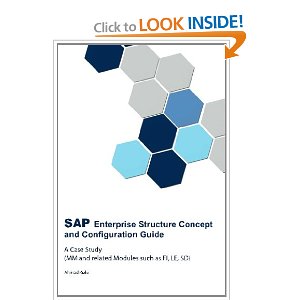Book Details
- Area: SAP MM Books
- Paperback: 62 pages
- Publisher: CreateSpace (August 29, 2010)
- Language: English
- ISBN-10: 1453763392
- ISBN-13: 978-1453763391
- Product Dimensions: 9 x 6 x 0.1 inches
Book Description
SAP enterprise structure is organizational structure that represents an enterprise in SAP ERP system. It consists of some organizational units which, for legal reasons or for other specific business-related reasons, are grouped together. Organizational units include legal company entities, sales offices, profit centers, etc. Organizational units handle specific business functions. Organizational units may be assigned to a single module (such as a sales organization is assigned to Sales and Distribution (SD) module, or to several modules (such as a plant is assigned to Materials Management (MM) and Production Planning (PP) module). SAP ERP system can represent a complex enterprise structure. Enterprise structure design is a fundamental process in a SAP implementation project. The design is mainly determined by the business scenarios performed in an enterprise. Once the design is determined, it will affect many things such as how to perform a transaction and generate reports on SAP system. Although it’s possible, it requires great effort to change the enterprise structure. So , we must ensure that the enterprise structure designed in the SAP implementation project can accommodate all business scenarios and enterprise’s requirements for current and future situation. The SAP Enterprise Structure is a fundamental setting and needs a comprehensive understanding of the business processes and their integration. We have to work with other departments and SAP modules, such as Accounting department (FI), and Sales department (SD). This book explains in details about the basic concept of SAP Enterprise Structure (MM and related modules such as FI, Logistics, and SD) and step by step how to configure it in SAP ERP system. To make it more understandable, it is supplied with a case study and the screen shots of each configuration step. It’s written in a simple-to-understand way, so you can learn it easily. You don’t need to have extensive SAP configuration skill and experience to be able to configure the SAP Enterprise Structure.
About the Author
Ahmad Rizki is an ERP Business Analyst Manager and also a Senior SAP Specialist at a leading CDMA-based telecommunication company in Indonesia. He had worked at various companies from various industries such as Oil & Gas Services, Geothermal Energy, Financial Services, and Telecommunication. The main functions that he experienced are Inventory Management, Procurement, Internal Audit, Sales & Distribution, and IT. He also has some full-cycle SAP implementation projects experience in some SAP modules such as Material Management (MM), Sales & Distribution, and Project System (PS). He has deep understanding about the integration between MM, SD, PS, and other SAP modules such as FICO, Plant Maintenance (PM), etc. With his experience and his educational background as an Industrial Engineer, he has a clear vision about various business processes and how to use the best-practice of them to support company’s strategic and operational activities to achieve its target. He also runs an SAP-related blog at www.SAPstudyMaterials.com where he writes several articles about various SAP concepts, configuration guide, etc. He is the ERPCX Country Ambassador for Indonesia. ERPCX is a global provider of SAP knowledge and resources.
Download this SAP MM book
If you want to download this book, please click the picture of the book. You will be redirected to Amazon website where you will offered with an option to download Kindle version of this SAP MM book or purchase a paper version of it.

